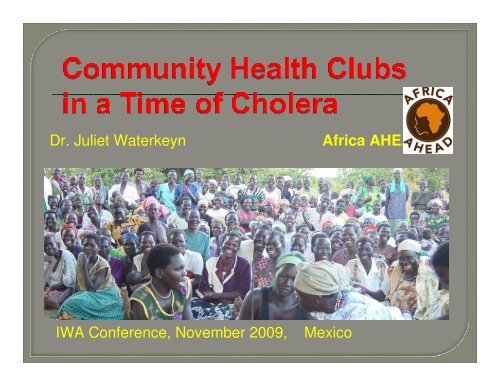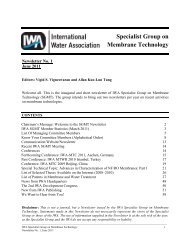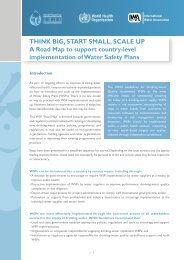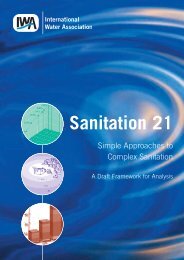Dr. Juliet Waterkeyn Africa AHEAD IWA Conference, November ...
Dr. Juliet Waterkeyn Africa AHEAD IWA Conference, November ...
Dr. Juliet Waterkeyn Africa AHEAD IWA Conference, November ...
You also want an ePaper? Increase the reach of your titles
YUMPU automatically turns print PDFs into web optimized ePapers that Google loves.
<strong>Dr</strong>. <strong>Juliet</strong> <strong>Waterkeyn</strong><br />
<strong>Africa</strong> <strong>AHEAD</strong><br />
<strong>IWA</strong> <strong>Conference</strong>, <strong>November</strong> 2009, Mexico
Outline of presentation: the issues...<br />
How to mobilise people in emergency situations<br />
Is the Community Health Club Approach viable<br />
for emergency programmes<br />
We examine two case studies where CHCs were used<br />
in 6 month emergency programmes:<br />
IDP Camps in Northern Uganda: 2005<br />
High density suburb in Mutare, Zimbabwe: 2009
NORTHERN UGANDA<br />
Insurgency for the past 18 years<br />
33 IDP Camps<br />
Population in each camp<br />
15,000 to 68,000
Camps guarded against continued rebel attacks<br />
Limited access to water<br />
Diarrhoea common<br />
>5% sanitation coverage<br />
Cholera outbreaks
AMBITIOUS TARGETS<br />
WITHIN 6 MONTHS<br />
HOW <br />
• 10,000 latrines<br />
• 120,000 people exposed to health promotion<br />
In each of the IDP 15 camps<br />
-<br />
• 50% households within a Community Health Club<br />
• 50% of Health Club members with household latrine<br />
NEEDED:<br />
120 clubs x 100 members (5-20 health clubs per IDP Camp)
87% completed<br />
all 20 sessions<br />
18,844 members were registered and given membership cards<br />
Cards were signed each time a member attended a session
Weekly health sessions were held for each club in 15 camps
75% CHC<br />
members<br />
11,709 health club members built drying racks in 6 months
11% CHC<br />
members<br />
53% CHC<br />
members<br />
1,682 Hand washing facilities (Tippy Taps) constructed<br />
8,145 bathing shelters constructed in 6 months
In each of<br />
15 camp a<br />
Sanitation<br />
CBO was<br />
formed.<br />
2,120<br />
wooden<br />
covers for<br />
sanplats<br />
Women<br />
trained to<br />
produce<br />
cement<br />
sanplats<br />
49 latrine<br />
pedestals<br />
made for<br />
disabled
72%<br />
constructed<br />
latrines<br />
New Technology introduced into Uganda<br />
for emergency sanitation in IDP Camps -<br />
effective in breaking the faecal-oral route<br />
+2,500 Poly sanplats installed + 2,120 cement sanplats
ACHIEVEMENTS<br />
Item Target 6 months<br />
Health Clubs 120 116<br />
Members 12,000 15,522<br />
Beneficiaries 120,000 93,132<br />
Latrines 10,000 11,256 (72%)<br />
Health sessions 2,400 2,760<br />
Sessions per club 20 +20
ZIMBABWE<br />
MANICALAND PROVINCE<br />
MUTARE<br />
High population mobility<br />
• 10 km from Mozambique also with cholera
NATIONAL CHOLERA EPIDEMIC<br />
Manicaland: 12 700 cases : 420 deaths<br />
Mutare City : 198 cases : 8 deaths<br />
‘We suspected that Sakubva would become the hot spot<br />
but it never developed......... The health clubs did their job’
Expected to become the hot spot for Cholera<br />
Blocked sewer system<br />
Overflowed in the rains<br />
Cracked water pipes<br />
4 cases suspected<br />
No deaths in Sakubva
• Started in October 2008<br />
• 37 Community Health Clubs formed<br />
• More than 5000 members across Sakubva<br />
• Meeting once weekly for health sessions<br />
• Massive clean-up campaign held
• Each club with about 130 members<br />
• Total number of members = approx. 5,000
STREET PRIDE<br />
Each household:<br />
Keeps drains unblocked<br />
Removes garbage<br />
Fill pot holes in road<br />
Use compost for plants
Street and Market Clean up<br />
Estimated saving to Council: US$20,000
Council is attending to sewers
1. Cases in Sakubva were far fewer than expected<br />
and no deaths recorded.<br />
2. In Buhera (one of worst Districts in Manicaland)<br />
No cholera where CHCs before the epidemic.<br />
3. Anecdotal reports Makoni District testify<br />
that CHCs have been able to control Cholera
Sakubva<br />
has<br />
changed :<br />
the place<br />
is clean<br />
now !<br />
Community<br />
participation in<br />
CHCs bring<br />
about<br />
community<br />
ownership of<br />
the sanitation<br />
Community<br />
responds positively<br />
for health when<br />
they see it as their<br />
responsibility
Lessons learnt<br />
Community Health Clubs<br />
are ideal in times of emergency<br />
Help communities get organised<br />
regain their sense of control over disaster<br />
Enables community surveillance and monitoring<br />
Can convert to long term programme<br />
Enable future preparedness
Community Health Clubs ensure a<br />
critical mass of organised people in effective<br />
community structures which can prevent all<br />
communicable diseases<br />
by good home hygiene.<br />
Cholera can be prevented because<br />
CHCs ensure high levels of<br />
positive behaviour change<br />
Reinforced and sustained by peer pressure.
<strong>Waterkeyn</strong>, J. and Cairncross, S. (2005) Creating demand for<br />
sanitation and hygiene through Community Health Clubs: a<br />
cost-effective intervention in two districts of Zimbabwe. Social<br />
Science & Medicine. Vol 61, pp.1958-1970.<br />
<strong>Waterkeyn</strong>, J, Okot, P., and Kwame, V. (2005) Rapid Sanitation<br />
Uptake in the Internally Displaced People Camps of Northern<br />
Uganda through Community Health Clubs. Kampala. 31 st WEDC<br />
<strong>Conference</strong>.<br />
For all publications, articles and more details on Community<br />
Health Clubs:<br />
www.africa ahead.com<br />
juliet@africaahead.com

















